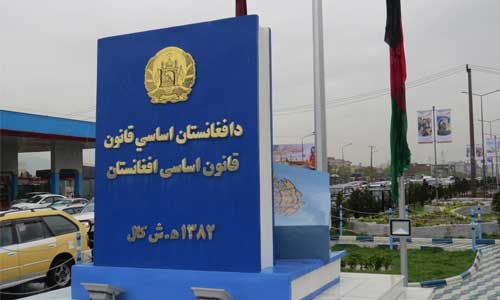This is more than a century that Afghanistan has been experiencing ups and downs with tolerating countless sacrifices until achieved the modern constitution in 2004. In 1880 When King Abd-al-Ra-man Khan occupied power, he established an absolute centralized monarchy while previously the political structure had been based on traditional jergas or legitimized by religious scholars. the opposition voices were harshly suppressed by the tyrant ruler, but later in the reign of Habibu-Allah Khan, it was responded by Afghan intelligentsia movement to convert it into a constitutional monarchy . The Afghan intelligentsia movement which is called the first constitutionalist movement were trained under the tutelage of progressive teachers, including Indian Muslims, in the new modern schools. the revolutionary upheavals elsewhere in the world such as Turkey, Russia and so on had also role in mobilizing the Afghan constitutionalists such as Wasif Qandahari and his colleagues who provided immediate inspiration and organizational leadership. Although the constitutionalists numbered only few among a predominantly illiterate population, they were confident, compatriot and dissatisfied with Habib-Allah’s friendly policy toward the British government of India and with the backwardness of the country.
Based on historic sources, the first constitutionalist organization was a secret national association aiming to establish a constitutional monarchy and a freely elected national assembly. With establishment of Seraj-Akhbar, the reformers also sought full independence from foreign domination, social justice, and modern civilization. Although the majority of the leaders hoped to achieve these reforms by peaceful means, the government spies warned the amir that the actual goal of the conspirators was to assassinate him and establish a “constitutional state.” As a result, Eight of them, including Wasif Qandahari, were dreadfully executed and thirty-five others imprisoned, all without trial. In addition, amir adopted a more reactionary line stopping Seraj-Al-Akhbar, and even his brother proposed to stop the modern educational institutions saying “Education produces constitutionalism, and constitutionalism is opposed to the power of the king. Despite this, In 1911, Mahmud Tarzi was granted permission to begin publication, under court supervision, of the newspaper Serāj al-akbār (successor to a publication of the same name founded by Mawlawi Abd-al-Rauf in 1906. Seraj al-akbar provided a forum for the Young Afghans, who were considered as second constitutionalist being dissatisfied with the king’s autocratic and pro-British policies and had rallied behind his second son, Aman-Allah, who was opposed to his father and finally the king Habibullah Khan was murdered on a hunting expedition in Laghman in February 1919.
As a result of the second constitutionalist movement, the first Afghan constitution (Nezam-nama-ye asasi) was adopted by a loya jerga In 1923. This constitution provided government composed of executive, legislative, and judicial branches, but the basic constitutionalist demand for an elected national assembly to which the government would be responsible was not realized. Rather, the document provided for a cabinet of ministers, led by and accountable to the king, rather than to the legislature; the king himself was declared not responsible to anybody. Nevertheless, all Afghans were granted relative democratic rights, regardless of faith or race with continuing to expand the system of modern education, even taught in some schools himself, as did his queen. Some of his more radical social reforms, for example, changing the weekly holiday from Friday to Thursday, forcing people in Kabul to wear Western uniforms and adopt Western forms of greeting, and banning veiled women from certain public places, aroused considerable opposition among traditional Afghans, opposition that eventually triumphed.
The second Afghan constitution was adopted In 1931 by a loya jerga, with recognition of Nader and his descendants as legitimate rulers of the country. Among the major differences from the constitution of a decade earlier were provisions for a cabinet accountable (except for the prime minister) to an elected national assembly and a house of elders the members of which were to be selected by the king; in practice, delegates for election to the assembly were also handpicked by the government. Another departure was constitutional recognition of the supremacy of the Hanafia jurisprudence and guarantee of the autonomy of the sharia courts. In spite this, the royal house maintained a monopoly of government power, and Afghanistan was only nominally a constitutional monarchy.
The third Afghan constitution was adopted in1964 by a loya Jerga in which Afghanistan was declared as a constitutional monarchy. Unlike the two previous constitutions, this one was more successful and more democratic. The national assembly (Wolesī jerga), provincial assemblies, and municipal councils were to be directly elected by the general population in secret ballots. One-third of the members of the senate (Meshrano jerga) were to be elected in the same way, one-third to be elected indirectly by the provincial councils, and one-third to be appointed by the king. The king was to nominate members of the cabinet, but they could be confirmed only by a vote in the assembly, to which they were to be accountable. Members of the king’s family, including paternal uncles and cousins, were barred from entering politics. Judges were to be appointed by the king but to function independently. All Afghan citizens were guaranteed the rights of free expression, rights of peaceful assembly, and of association. The police could neither make arrests nor enter private homes or confiscate property without warrants granted by the courts. Furthermore, individual freedom was guaranteed, and the free media blossomed once again, and political parties became active under the protection of free association, even though they had still not been explicitly legalized. The next three constitutions of Afghanistan were orderly adopted during reign of Dawood Khan, Dr. Najibullah and Hamid Karzai which will be discussed in the next pieces.
Home » Opinion » The Ups and Downs of Constitutional Development in Afghanistan
The Ups and Downs of Constitutional Development in Afghanistan
| Mohammad Zahir Akbari

